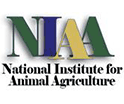

Point A: The science behind the emergence, amplification, persistence and transfer of antibiotic resistance is highly complex and open to interpretation-and sometimes misinterpretation-from a wide variety of perspectives and misuse. If you think you understand antimicrobial resistance, it hasn't been explained properly to you.
Point B: The extremely complex relationship between animal health, human health and environmental health is driven by two premises: 1) Antimicrobial resistance is a naturally occurring phenomenon that is present with or without the use of antimicrobials; and 2) Anytime an antibiotic enters the ecosystem, it has the potential to contribute to the development of antibiotic resistance.
These two points were among the many shared during the "Bridging the Gap between Animal Health and Human Health" symposium sponsored by the National Institute for Animal Agriculture and conducted Nov. 12-14, 2013, in Kansas City, Mo. These points and additional information synthesized from the symposium comprise a 27-page "Bridging the Gap between Animal Health and Human Health" symposium White Paper recently released by NIAA.
"This White Paper highlights information delivered during the symposium by 20 different speakers-including antibiotic use and resistance experts representing animal health, human health and public health as well as a consumer advocate organization, grocery retailers, staff members and selected media representing agriculture and consumer advocates," states Dr. Nevil Speer, PhD, Western Kentucky University, and co-chair of the "Bridging the Gap between Animal Health and Human Health" symposium.
"Open and candid presentations and discussions emphasized that those in human health and in animal health are committed to continuous improvement and are working to find common ground so a collective path forward can be formulated. Having a tug-of-war of human versus agricultural use of antibiotics doesn't advance a solution. This paper underscores the importance of taking a 360-degree view and addressing antibiotic resistance from an all-inclusive, science-based perspective."
The Antimicrobial Use and Resistance White Paper is available online at www.animalagriculture.org. Many of the symposium's PowerPoint presentations, including the audio, are available in full online at www.animalagriculture.org.
The National Institute for Animal Agriculture provides a forum for building consensus and advancing proactive solutions for animal agriculture-the beef, dairy, swine, sheep, goats, equine, poultry and aquaculture industries-and provides continuing education and communication linkages for animal agriculture professionals. NIAA is dedicated to programs that work towards the eradication of disease that pose risk to the health of animals, wildlife and humans; promote a safe and wholesome food supply for our nation and abroad; and promote best practices in environmental stewardship, animal health and well-being. NIAA members represent all facets of animal agriculture.
1.10.2014